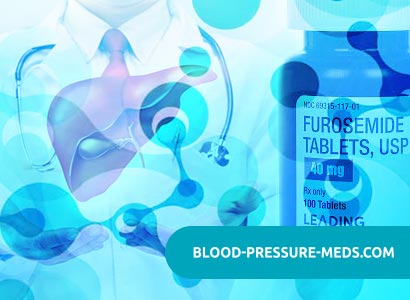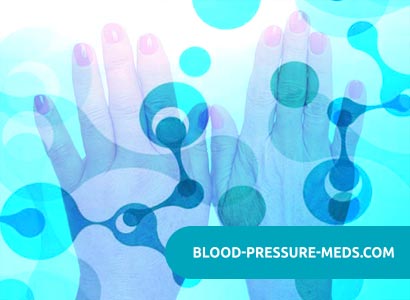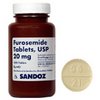Pharmacodynamics
Furosemide is a strong and fast-acting diuretic derived from sulfonamide. Furosemide blocks the system of Na + K + SG ion transport in the thick segment of the ascending knee of the loop of Henle, and therefore its diuretic effect depends on the drug entering the lumen of the renal tubules (due to the mechanism of anion transport). The diuretic effect of furosemide is associated with inhibition of sodium chloride reabsorption in this section of the loop of Henle. Secondary effects with respect to an increase in sodium excretion are: an increase in the amount of urine secreted (due to osmotically bound water) and an increase in potassium secretion in the distal part of the renal tubule. At the same time increases the excretion of calcium and magnesium ions. When the canalicular secretion of furosemide decreases or when the drug is bound to albumin in the tubule lumen (for example, in nephrotic syndrome), the effect of furosemide decreases. In course taking Furosemide, its diuretic activity does not decrease, since the drug interrupts the canalotropic-glomerular feedback in Macula densa (the canalicular structure closely associated with the juxtaglomerular complex). Furosemide induces a dose-dependent stimulation of the renin-angiotensin-aldosterone system.
In heart failure, furosemide rapidly reduces preload (due to the expansion of the veins), decreases the pressure in the pulmonary artery and the filling pressure of the left ventricle. This rapidly developing effect appears to be mediated through the effects of prostaglandins and therefore the condition for its development is the absence of impairments in the synthesis of prostaglandins, in addition to which this effect also requires sufficient preservation of renal function.

The drug has a hypotensive effect, which is caused by an increase in sodium excretion, a decrease in circulating blood volume and a decrease in the reaction of vascular smooth muscle to vasoconstrictor stimuli (due to the natriuretic effect, furosemide reduces the vascular response to catecholamines, which are increased in patients with arterial hypertension).
After ingestion of 40 mg of furosemide, the diuretic effect begins within 60 minutes and lasts about 3-6 hours.
In healthy volunteers who received from 10 to 100 mg of furosemide, dose-dependent diuresis and natriuresis were observed.
Pharmacokinetics
Furosemide is rapidly absorbed in the gastrointestinal tract. Its tmax (time to reach maximum concentration in the blood) is from 1 to 1.5 hours. The bioavailability of furosemide in healthy volunteers is approximately 5070%. In patients with bioavailability of furosemide can be reduced to 30%, since it can be influenced by various factors, including the underlying disease. The volume of distribution of furosemide is 0.1-0.2 l / kg body weight. Furosemide is very strongly bound to plasma proteins (more than 98%), mainly albumin.
Furosemide is excreted mainly in unchanged form and mainly by secretion in the proximal tubule. The gluconated metabolites of furosemide account for 10–20% of the renal excreted drug. The remaining dose is excreted through the intestines, apparently by biliary secretion.
The final half-life of furosemide is approximately 1-1.5 hours.
Furosemide penetrates the placental barrier and is secreted into the mother's milk. Its concentrations in the fetus and newborn are the same as in the mother.
Features of pharmacokinetics in certain groups of patients
In renal failure, the elimination of furosemide is slowed down, and the half-life is increased; with severe renal failure, the final half-life may increase to 24 hours.
In nephrotic syndrome, a decrease in plasma concentrations of proteins leads to an increase in the concentrations of unbound furosemide (its free fraction), therefore, the risk of ototoxic action increases. On the other hand, the diuretic effect of furosemide in these patients may be reduced due to the binding of furosemide to albumin in the tubules and a decrease in the tubular secretion of furosemide.
During hemodialysis and peritoneal dialysis and continuous outpatient peritoneal dialysis, furosemide is slightly excreted.
In liver failure, the half-life of furosemide is increased by 30-90% mainly due to an increase in the volume of distribution. Pharmacokinetic indicators in this category of patients can vary greatly.
In heart failure, severe hypertension and in the elderly, the elimination of furosemide is slowed down due to a decrease in renal function.
Indications for use
- edematous syndrome in chronic heart failure;
- edematous syndrome in chronic renal failure;
- acute renal failure, including those during pregnancy and burns (to maintain fluid excretion);
- edema syndrome in nephrotic syndrome (in nephrotic syndrome in the foreground is the treatment of the underlying disease);
- edematous syndrome in liver diseases (if necessary, in addition to treatment with aldosterone antagonists);
- arterial hypertension.
Contraindications
- hypersensitivity to the active substance or to any of the components of the drug; patients allergic to sulfonamides (sulfanilamide antimicrobial agents or sulfonylurea drugs) may have a cross-allergy to furosemide;
- renal failure with anuria (in the absence of a reaction to furosemide);
- hepatic coma and precoma;
- severe hypokalemia;
- severe hyponatremia;
- hypovolemia (with or without hypotension) or dehydration;
- pronounced violations of urine outflow of any etiology (including unilateral damage to the urinary tract);
- digitalis intoxication;
- acute glomerulonephritis;
- decompensated aortic and mitral stenosis, hypertrophic obstructive cardiomyopathy;
- increase in central venous pressure (over 10 mmHg);
- hyperuricemia;
- children's age up to 3 years (solid dosage form);
- pregnancy;
- breastfeeding period.
With care: arterial hypotension; conditions in which an excessive decrease in blood pressure is particularly dangerous (stenosing lesions of the coronary and / or cerebral arteries); acute myocardial infarction (increased risk of cardiogenic shock), latent or manifest diabetes mellitus; gout; hepatorenal syndrome; hypoproteinemia, for example, in nephrotic syndrome, in which it is possible to reduce the diuretic effect and increase the risk of the development of the ototoxic effect of furosemide, therefore, the dose selection in such patients should be carried out with extreme caution); disorders of urine outflow (prostatic hypertrophy, narrowing of the urethra or hydronephrosis); pancreatitis, diarrhea, a history of ventricular arrhythmia, systemic lupus erythematosus.
Pregnancy and lactation period
Furosemide penetrates the placental barrier, so it should not be prescribed during pregnancy. If for life reasons Furosemide is prescribed to pregnant women, then careful monitoring of the condition of the fetus is necessary.
During lactation, furosemide is contraindicated. Furosemide inhibits lactation.
Dosage and administration
General recommendations:
Tablets should be taken on an empty stomach, not chewed and squeezed with a sufficient amount of liquid. When prescribing Furosemide, it is recommended to use its lowest doses sufficient to achieve the desired effect.
The recommended maximum daily intake for adults is 1500 mg. In children, the recommended oral dose is 2 mg / kg body weight (but not more than 40 mg per day).
The duration of treatment is determined by the doctor individually, depending on the evidence.
Special recommendations for dosing regimen in adults
Edematous syndrome in chronic heart failure
The recommended initial dose is 20-80 mg per day. The required dose is selected depending on the diuretic response. It is recommended that the daily dose should be divided into two or three doses.
Edema syndrome in chronic renal failure
The natriuretic reaction to furosemide depends on several factors, including the severity of renal failure and the sodium content in the blood, so the dose effect cannot be accurately predicted. Patients with chronic renal failure require careful selection of the dose, by gradually increasing it so that fluid loss occurs gradually (at the beginning of treatment, loss of fluid to about 2 kg of body weight per day is possible).
The recommended starting dose is 40-80 mg per day. The required dose is selected depending on the diuretic response. The entire daily dose should be taken once or divided into two doses. In patients on hemodialysis, the maintenance dose is usually 250–1500 mg / day.
Acute renal failure (to maintain fluid excretion)
Before starting treatment with furosemide, hypovolemia, hypotension and significant electrolyte and acid-base disorders should be eliminated. It is recommended to transfer the patient from intravenous administration of Furosemide to the reception of Furosemide tablets as soon as possible (the dose of Furosemide tablets depends on the selected intravenous dose).
Edema in nephritic syndrome
The recommended initial dose is 40 - 80 mg per day. The required dose is selected depending on the diuretic response. The daily dose can be taken in a single dose or divided into several doses.
Edematous syndrome in liver diseases
Furosemide is prescribed in addition to treatment with aldosterone antagonists in case of their lack of effectiveness. To prevent the development of complications, such as impaired orthostatic regulation of blood circulation or impaired electrolyte or acid-base status, careful dose selection is required so that fluid loss occurs gradually (at the beginning of treatment, loss of fluid is possible to approximately 0.5 kg of body weight per day). The recommended initial dose is 20-80 mg per day.
Arterial hypertension
Furosemide can be used in monotherapy or in combination with other antihypertensive drugs.
The usual maintenance dose is 20–40 mg daily. With hypertension in combination with chronic renal failure, the use of higher doses of Furosemide may be necessary.
Side effect
From the water-electrolyte and acid-base state
Hyponatremia, hypochloremia, hypokalemia, hypomagnesemia, hypocalcemia, metabolic alkalosis, which can develop as either a gradual increase in electrolyte deficiency or massive electrolyte loss in a very short time, for example, in the case of receiving high doses of furosemide by patients with normal kidney function. Symptoms that indicate the development of electrolyte and acid-base disorders can be headache, confusion, convulsions, tetany, muscle weakness, cardiac arrhythmias, and dyspeptic disorders. Factors contributing to the development of electrolyte disorders are major diseases (eg, cirrhosis of the liver or heart failure), concomitant therapy, and poor diet. In particular, with vomiting and diarrhea, the risk of hypokalemia may increase.

Hypovolemia (decrease in circulating blood volume) and dehydration (more often in elderly patients), which can lead to hemoconcentration with a tendency to develop thrombosis.
Since the cardiovascular system
Excessive reduction in blood pressure, which, especially in elderly patients, may manifest the following symptoms: impaired concentration and psychomotor reactions, headache, dizziness, drowsiness, weakness, visual disturbances, dry mouth, and impaired orthostatic blood circulation regulation; collapse.
Metabolism
Increased serum levels of cholesterol and triglycerides. Transient elevation of creatinine and urea in the blood. Increased serum concentrations of uric acid, which can cause or increase the manifestations of gout.
Decreased glucose tolerance (latent diabetes mellitus is possible to manifest).
On the part of the urinary system
The appearance or strengthening of symptoms due to the existing obstacle to the outflow of urine up to acute urinary retention with subsequent complications (for example, in prostatic hypertrophy, narrowing of the urethra, hydronephrosis); hematuria, decreased potency.
From the gastrointestinal tract
Rarely - nausea, vomiting, diarrhea, constipation; isolated cases of intrahepatic cholestasis, elevated levels of hepatic transaminases, acute pancreatitis.
From the central nervous system, organ of hearing
In rare cases - hearing loss, usually reversible, and / or tinnitus, especially in patients with renal insufficiency or hypoproteinemia (nephrotic syndrome), rarely - paresthesia.
On the part of the skin, allergic reactions
Rarely - allergic reactions: pruritus, urticaria, other types of rash or bullous skin lesions, polymorphic erythema, exfoliative dermatitis, purpura, fever, vasculitis, interstitial nephritis, eosinophilia, photosensitization. It is extremely rare - severe anaphylactic or anaphylactoid reactions up to shock, which until now have been described only after intravenous administration.
Peripheral blood
Rarely - thrombocytopenia. In rare cases, leukopenia.
In some cases, agranulocytosis, aplastic anemia or hemolytic anemia. Since some adverse reactions (such as a change in the blood picture, severe anaphylactic or anaphylactoid reactions, severe skin allergic reactions) can, under certain conditions, threaten the lives of patients, any side effects should be immediately reported to your doctor.
Overdose
If an overdose is suspected, it is imperative that you seek medical attention, as in the event of an overdose, certain therapeutic measures may be required.
The clinical picture of an acute or chronic overdose of a drug depends mainly on the degree and consequences of the loss of fluid and electrolytes; overdose may be manifested by hypovolemia, dehydration, hemoconcentration, abnormal heart rhythm and conduction (including atrioventricular block and ventricular fibrillation). Symptoms of these disorders are hypotension (up to the development of shock), acute renal failure, thrombosis, delirium, flaccid paralysis, apathy and confusion.
There is no specific antidote. If a little time has passed after ingestion, to reduce the absorption of furosemide from the gastrointestinal tract, you should try to induce vomiting or gastric lavage, and then ingest activated charcoal. The treatment is aimed at correcting clinically significant disorders of water-electrolyte and acid-base status under the control of serum concentrations of electrolytes, indicators of acid-base status, hematocrit, as well as the prevention or therapy of possible serious complications developing on the background of these disorders.
Interaction with other drugs
Cardiac glycosides, drugs that cause prolongation of the QT interval — if electrolyte disturbances develop in the background of receiving furosemide (hypokalemia or hypomagnesemia), the toxic effect of cardiac glycosides and drugs that prolong the QT interval increases (the risk of developing rhythm increases).
Glucocorticosteroids, carbenoxolone, liquorice in large quantities and prolonged use of laxatives when combined with furosemide increase the risk of developing hypokalemia.
Aminoglycosides - slowing down the excretion of aminoglycosides by the kidneys while they are used concomitantly with furosemide and increasing the risk of the development of ototoxic and nephrotoxic action of aminoglycosides. For this reason, the use of this combination of drugs should be avoided, unless it is necessary for health reasons, and in this case, correction (reduction) of maintenance doses of aminoglycosides is required. Drugs with nephrotoxic action - when combined with furosemide increases the risk of their nephrotoxic action.
High doses of some cephalosporins (especially those with predominantly renal excretion) - in combination with furosemide increases the risk of nephrotoxic action.
Cisplatin - when used concurrently with furosemide, there is a risk of ototoxic action. In addition, in the case of co-administration of cisplatin and furosemide in doses above 40 mg (with normal renal function), the risk of the development of the nephrotoxic effect of cisplatin increases.
Non-steroidal anti-inflammatory drugs (NSAIDs) - NSAIDs, including acetylsalicylic acid, can reduce the diuretic effect of furosemide. In patients with hypovolemia and dehydration (including against the background of taking furosemide), NSAIDs can cause the development of acute renal failure. Furosemide may enhance the toxic effect of salicylates.
Phenytoin - a decrease in the diuretic effect of furosemide. Hypotensive agents, diuretics, or other agents that can lower blood pressure - when combined with furosemide, a more pronounced hypotensive effect is expected.
Angiotensin-converting enzyme (ACE) inhibitors - the appointment of an ACE inhibitor to patients who have previously received treatment with furosemide may lead to an excessive decrease in blood pressure with deterioration of renal function, and in some cases to the development of acute renal failure, therefore, three days before the start of treatment with inhibitors ACE or increasing their dose is recommended cancellation of furosemide, or reducing its dose.
Probenecid, methotrexate, or other drugs that, like furosemide, are secreted in the renal tubules, can reduce the effects of furosemide (the same path of renal secretion), on the other hand, furosemide can lead to a decrease in kidney excretion of these medicines.
Hypoglycemic agents, pressor amines (epinephrine, norepinephrine) - weakening effects when combined with furosemide. Theophylline, diazoxide, curare-like muscle relaxants - increased effects when combined with furosemide.
Lithium salts - under the influence of furosemide, lithium excretion is reduced, thereby increasing the serum concentration of lithium and increasing the risk of the development of the toxic effect of lithium, including its damaging effects on the heart and nervous system. Therefore, when using this combination, control of serum lithium concentrations is required. Sucralfate - reducing the absorption of furosemide and reducing its effect (furosemide and sucralfate should be taken at least two hours apart).
Cyclosporin A - when combined with furosemide increases the risk of developing gouty arthritis due to hyperuricemia caused by furosemide, and cyclosporine disturbances in the excretion of urates by the kidneys. Radiocontrast agents - in patients with a high risk of nephropathy for the administration of radiopaque drugs treated with furosemide, there was a higher incidence of renal dysfunction compared with patients with a high risk of nephropathy for radiopaque drugs that received only intravenous hydration before radiopaque drug.
Special instructions
Before starting treatment with Furosemide, it is necessary to exclude the presence of sharply expressed violations of urine outflow, including unilateral ones. Patients with a partial violation of the outflow of urine need careful observation, especially at the beginning of treatment with furosemide.
During treatment with furosemide, regular monitoring of serum concentrations of sodium, potassium and creatinine is usually required, especially careful monitoring should be carried out in patients with a high risk of developing water-electrolyte imbalance in cases of additional fluid and electrolyte loss (for example, due to vomiting, diarrhea or intense sweating).
Before and during treatment with Furosemide, it is necessary to control and, in case of occurrence, eliminate hypovolemia or dehydration, as well as clinically significant disorders of water-electrolyte and / or acid-base status, which may require a short-term discontinuation of treatment with Furosemide.
When treating with Furosemide, it is always advisable to eat foods rich in potassium (lean meat, potatoes, bananas, tomatoes, cauliflower, spinach, dried fruits, etc.). In some cases, it may be shown taking potassium supplements or prescribing potassium-sparing drugs.
Some side effects (for example, a significant reduction in blood pressure and the accompanying symptoms) can impair the ability to concentrate and reduce psychomotor reactions, which can be dangerous when driving or working with mechanisms. This applies particularly to the period of initiation of treatment or increasing the dose of the drug, as well as to the cases of simultaneous administration of antihypertensive drugs or ethanol.
 US
US AU
AU CA
CA DE
DE FR
FR IT
IT ES
ES



